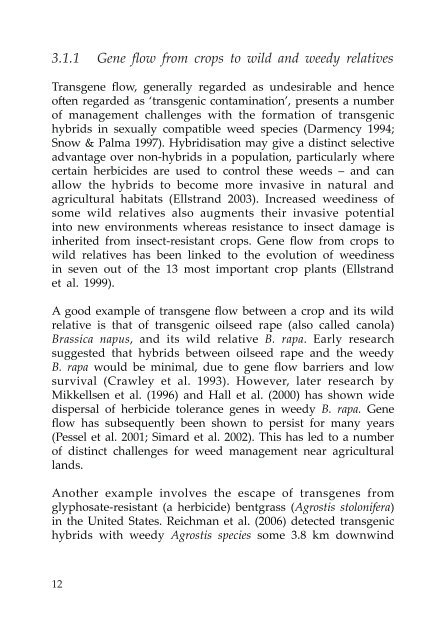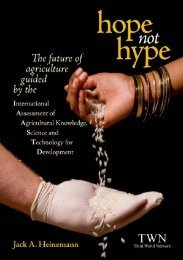gene Flow: Implications for Crop Diversity and Wild Relatives
gene Flow: Implications for Crop Diversity and Wild Relatives
gene Flow: Implications for Crop Diversity and Wild Relatives
- No tags were found...
Create successful ePaper yourself
Turn your PDF publications into a flip-book with our unique Google optimized e-Paper software.
3.1.1 Gene flow from crops to wild <strong>and</strong> weedy relativesTrans<strong>gene</strong> flow, <strong>gene</strong>rally regarded as undesirable <strong>and</strong> henceoften regarded as ‘transgenic contamination’, presents a numberof management challenges with the <strong>for</strong>mation of transgenichybrids in sexually compatible weed species (Darmency 1994;Snow & Palma 1997). Hybridisation may give a distinct selectiveadvantage over non-hybrids in a population, particularly wherecertain herbicides are used to control these weeds – <strong>and</strong> canallow the hybrids to become more invasive in natural <strong>and</strong>agricultural habitats (Ellstr<strong>and</strong> 2003). Increased weediness ofsome wild relatives also augments their invasive potentialinto new environments whereas resistance to insect damage isinherited from insect-resistant crops. Gene flow from crops towild relatives has been linked to the evolution of weedinessin seven out of the 13 most important crop plants (Ellstr<strong>and</strong>et al. 1999).A good example of trans<strong>gene</strong> flow between a crop <strong>and</strong> its wildrelative is that of transgenic oilseed rape (also called canola)Brassica napus, <strong>and</strong> its wild relative B. rapa. Early researchsuggested that hybrids between oilseed rape <strong>and</strong> the weedyB. rapa would be minimal, due to <strong>gene</strong> flow barriers <strong>and</strong> lowsurvival (Crawley et al. 1993). However, later research byMikkellsen et al. (1996) <strong>and</strong> Hall et al. (2000) has shown widedispersal of herbicide tolerance <strong>gene</strong>s in weedy B. rapa. Geneflow has subsequently been shown to persist <strong>for</strong> many years(Pessel et al. 2001; Simard et al. 2002). This has led to a numberof distinct challenges <strong>for</strong> weed management near agriculturall<strong>and</strong>s.Another example involves the escape of trans<strong>gene</strong>s fromglyphosate-resistant (a herbicide) bentgrass (Agrostis stolonifera)in the United States. Reichman et al. (2006) detected transgenichybrids with weedy Agrostis species some 3.8 km downwind12
















